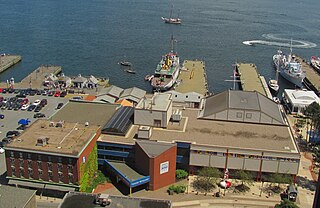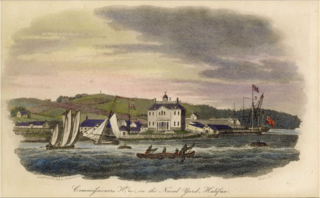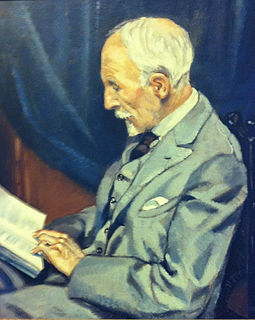
Colonel Joseph Frederick Wallet Des Barres was a cartographer who served in the Seven Years' War, as the aide-de-camp to General James Wolfe. He later went on to serve as the Lieutenant-Governor of Cape Breton and later as Lieutenant-Governor of Prince Edward Island.

The Maritime Museum of the Atlantic is a maritime museum located in downtown Halifax, Nova Scotia, Canada.

Hosting the region's largest urban population, Halifax, Nova Scotia is an important cultural centre in Atlantic Canada. Halifax is home to a vibrant arts and culture community that enjoys considerable support and participation from the general population. As the largest community and the administrative centre of the Atlantic region since its founding in 1749, Halifax has long-standing tradition of being a cultural generator. While provincial arts and culture policies have tended to distribute investment and support of the arts throughout the province, sometimes to the detriment of more populous Halifax, cultural production in the region is increasingly being recognized for its economic benefits, as well as its purely cultural aspects.
Lieutenant-General William Spry (1734–1802) was born in Titchfield, Hampshire, in 1734, the son of George Spry and Elizabeth Short.

Royal Naval Dockyard, Halifax was a Royal Navy base in Halifax, Nova Scotia. Established in 1759, the Halifax Yard served as the headquarters for the Royal Navy's North American Station for sixty years, starting with the Seven Years' War. The Royal Navy continued to operate the station until it was closed in 1905. The station was sold to Canada in 1907 becoming Her Majesty's Canadian Dockyard, a function it still serves today as part of CFB Halifax.

St. Paul's Church is an evangelical Anglican church in downtown Halifax, Nova Scotia, within the Diocese of Nova Scotia and Prince Edward Island of the Anglican Church of Canada. It is located at the south end of the Grand Parade, an open square in downtown Halifax with Halifax City Hall at the northern end.

Guysborough is an unincorporated Canadian community in Guysborough County, Nova Scotia.

The history of Nova Scotia covers a period from thousands of years ago to the present day. Prior to European colonization, the lands encompassing present-day Nova Scotia were inhabited by the Mi'kmaq people. During the first 150 years of European settlement, the region was claimed by France and a colony formed, primarily made up of Catholic Acadians and Mi'kmaq. This time period involved six wars in which the Mi'kmaq along with the French and some Acadians resisted the British invasion of the region. During Father Le Loutre's War, the capital was moved from Annapolis Royal, Nova Scotia, to the newly established Halifax, Nova Scotia (1749). The warfare ended with the Burying the Hatchet ceremony (1761). After the colonial wars, New England Planters and Foreign Protestants emigrated to Nova Scotia. After the American Revolution, Loyalists emigrated to the colony. During the nineteenth century, Nova Scotia became self-governing in 1848 and joined the Canadian Confederation in 1867.
Nova Scotia Museum (NSM) is the corporate name for the 27 museums across Nova Scotia, Canada, and is part of the province's tourism infrastructure. The organization manages more than 200 historic buildings, living history sites, vessels, specialized museums and about one million artifacts and specimens, either directly or through a system of co-operative agreements with societies and local boards. The NSM delivers programs, exhibits and products which provide both local residents and tourists in Nova Scotian communities an opportunity to experience and learn about Nova Scotia's social and natural history. More than 600,000 people visit the facilities each year.

Harry Piers (1870–1940) was a Canadian historian. He was a long-serving and influential historian and curator at the Nova Scotia Museum in Halifax, Nova Scotia. Piers was born on February 12, 1870 in Halifax.

Cole Harbour is a community in the Canadian province of Nova Scotia, located in Guysborough County.

The Raid on Lunenburg occurred during the American Revolution when the US privateer, Captain Noah Stoddard of Fairhaven, Massachusetts, and four other privateer vessels attacked the British settlement at Lunenburg, Nova Scotia on July 1, 1782. The raid was the last major privateer attack on a Nova Scotia community during the war.
This is a bibliography of major works on Nova Scotia.
Saladin was a British barque that made voyages between Britain and the coast of Peru, carrying shipments of guano. The ship is best known for its demise in an act of mutiny, murder and piracy which began with the murder of its captain and officers and ended with the ship being stranded off the coast of Nova Scotia on 21 May 1844, followed by the last major piracy trial in Canada.

The Devils Island Light is a Nova Scotia lighthouse located at the eastern shore entrance to Halifax Harbour on Devils Island, Nova Scotia. First lit in 1852, it was succeeded by a second lighthouse in 1877 which survives today. The lighthouse has influenced regional folklore and remains an important community landmark although it is currently neglected and threatened.

Steven Laffoley is a Canadian author of creative nonfiction and fiction.
The Royal Nova Scotia Historical Society is a historical society in Halifax, Nova Scotia that was founded in 1878 and is the second oldest in Canada The Society is a voluntary organization that operates without an office or paid staff. The Society first published the Nova Scotia Historical Quarterly and then the Nova Scotia Historical Review. Eventually the publication was named the Collections of the Royal Nova Scotia Historical Society and now it is known as the Journal of the Royal Nova Scotia Historical Society.

The Local Council of Women of Halifax (LCWH) is an organization in Halifax, Nova Scotia devoted to improving the lives of women and children. One of the most significant achievements of the LCWH was its 24-year struggle for women's right to vote (1894-1918). The core of the well trained and progressive leadership was five women: Anna Leonowens, Edith Archibald, Eliza Ritchie, Agnes Dennis and May Sexton. Halifax business man George Henry Wright left his home in his will to the LCWH, which the organization received after he died in the Titanic (1912). Educator Alexander McKay also was a significant supporter of the Council.

Cambridge Military Library is a public library building in Royal Artillery Park in Halifax, Nova Scotia, Canada which was created in 1886. The building was created to house the garrison library collection, which had been moved from various locations in the city since its creation in 1817. It is the oldest library collection in Atlantic Canada. This building was the social and literary centre of military Halifax. In 1902, the officers of the garrison requested the library be named after the Prince George, Duke of Cambridge.
Stephen Edward Kimber is a Canadian journalist, editor and broadcaster and professor at the University of King's College in Halifax, Nova Scotia.















